
New HP 49G+ Calculator
 |
New HP 49G+ Calculator |
First, a disclaimer. Because HP no longer develops its own calculators, my web site does not give me any kind of "in" with the developers. This means I have not signed any NDAs and am not restricted from posting any information that I glean off newsgroups or from other sources.
Hewlett-Packard should be releasing the HP 49G+ in the September timeframe, so it will miss the initial back-to-school sales. It appears that this will replace the 49G. Specifications (subject to change) are as follows:
Note that the processor is not a Saturn, but instead it is an embedded CPU common in devices such as cable modems and routers. As a result, I suspect that it is running some kind of emulation layer to run the 49G code. It is possible that all the assembly language code from the 49 was rewritten in a higher-level language for the ARM, but I believe that would raise the development costs too high. I suspect that it either has a very low-level emulator of a Saturn to make the processor appear to be a Saturn (essentially the emulator would be the operating system) or it has a higher-level simulator (think along the lines of an optimized Emu48) running on top of another operating system.
I am extremely anxious to get my hands on one of these so I can learn how it works. It appears to be better than the 49G in every single way -- the key legends have higher contrast (more attractive color, too), the screen is bigger, more memory is available, the keys are no longer rubber, infrared has returned, and the price has dropped $4 (the 49G was $179.99).
Battery life should be reasonably good, possibly similar to that of the 49G (the 49G uses around 100 mW, most of which is probably the CPU).
The only disappointments so far are that the display is not as high of a resolution as one might hope (still, it's 25% bigger than the 49G's), and the case is still metallic-painted plastic, which I personally think is the worst mistake in industrial design today, instead of either unpainted plastic or real metal, both of which are much more attractive.
The quality of the keyboard still remains to be seen. I hope I will like the new plastic keys. They are rumored to be a return of the 48's keys, which, if true, pleases me beyond belief.
The keyboard layout is virtually the same as that of the 49, with only a few minor changes. Interestingly, the changes all seem to be ones that were requested on the newsgroup at one time or another. EVAL and CAT have swapped, so EVAL is no longer shifted. I like this change a lot. EQW and ['] have swapped as well; I will probably swap them back with user keys. Everything else is unchanged. The F1-F6 keys appear slightly larger and the G-L keys appear slightly smaller. All the labels are bigger, which is a big plus for those with older eyes.
The return of the expansion slot, something available on the 48 since 1990 and the 41 since 1979, is a huge plus. Since it (hopefully) uses standard SD memory cards, one might be able to add 32MB for under $20 or 64MB for under $30, assuming the calculator can address that much space. This should be great for surveyors (at least those who still use calculators for data collection, instead of the much more expensive dedicated devices) or ordinary users who just want to load a lot of software.
Some more new models are on their way as well. Expect to see the 48GII for $130 and the 17BII+ for $120 very soon. The $66 33S and $100 39G+ should arrive soon after the 49G+ (hopefully late October), and the 19BII+ is expected to cost $170 in January.
My personal opinion is that the 48GII color scheme is more attractive than that of the 49G+. Attention was paid to contrast, fortunately, so everything looks easy to read (except the Z, but who cares about one letter?). The use of RS-232 on the 48GII is interesting. I first thought that maybe it was to maintain compatibility with existing HP48 serial devices (survey links, etc), but given the lack of memory it wouldn't make sense for surveying. The 33S has a really weird layout. Maybe it's more ergonomic than it looks, but judging by the picture, I'd say HP's dominance in math competitions where calculator competence is required (such as the Texas UIL competition, where everyone uses 32SII's in order to win) is over. What was HP's industrial design contractor thinking when they designed that keyboard, or were they simply not thinking?
Hewlett-Packard has produced some PDF documents with more information about the 48GII, 39G+, 49G+, and 33S. Beware, however, because they have at least as many typos as the 49G+ document had before I corrected most of them (you can tell these are real because of the mistakes, hopefully because these are just early drafts -- if I were making this as a hoax, I would be sure to make everything seem accurate). The documents are:
 |
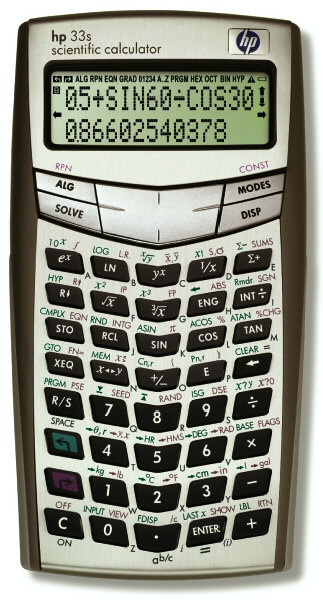 |
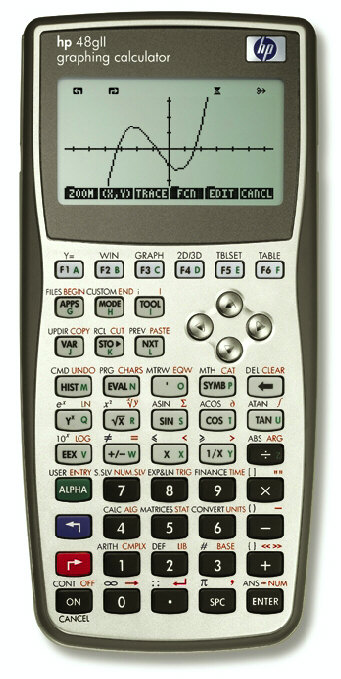 |
I have been able to get a few more photos taken of an actual 49G+ calculator. I have not seen the calculator myself, but these come from some anonymous sources. Pictured below are the USB port, the SD slot, the front of the calculator, a sample page from the manual, and the packaging for the Latin American market. Click on the latter three images for a full-sized version.
 |
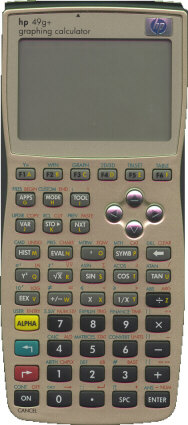 |
 | |
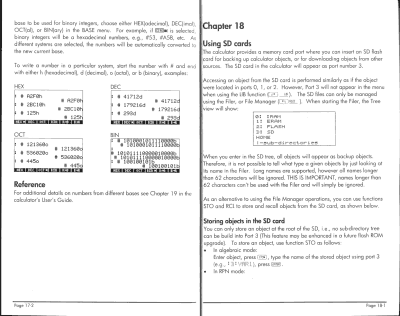 |
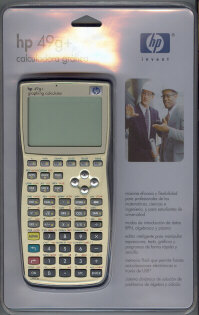 |
I do have some comments about the prototype model shown above. The first print edition of the manual is not complete and still has flaws (such as some things supposedly being partially explained, but not explained enough for a beginner to actually reproduce on the calculator), but the included version on the CD should be more complete. The manual is partially based on Science and Engineering Mathematics with the 49G. Formatting is poor at times, but again, this may be fixed in a later edition.
Performance is improved over the 49G. As a really simple example, calculating 300!, which takes about 2-3 seconds on the 49G, takes about a second on the 49G+. Graphing works a lot better now. The keyboard is similar in some ways to that of the 48, but supposedly it feels a lot cheaper and more "snappy". Hopefully this is solved in the production models, but supposedly it is possible to make the key click without having the calculator register the keypress, so the click may not have anything to do with the electrical connection. I really hope this will be solved, because it makes the clicks rather useless. The new 17 will use this same keyboard, and the 12C Platinum already uses this keyboard.
The catalog now shows 762 commands. The equation writer does not fill the whole screen (only the bottom 131x64), with the status bar appearing on the top. The self diagnostic tests (On-D) are a bit improved, with a nice new keyboard test, a USB test, an IrDA test, and a buzzer test, which allows you to set the frequency being tested.
I also have a copy of the first 175 pages of the 48GII documentation (this is the "Quick Start" guide). The first production calculators will only come with the Quick Start Guide, but there should be a coupon included to receive the full manual (800 pages or so) free of charge. You can download the 48GII Quick Start Guide here.
Please do not contact me asking for more details about any upcoming HP calculators. Everything I know is already on this page, and I cannot tell you more. If, however, you have corrections or additions to my information, please contact me.